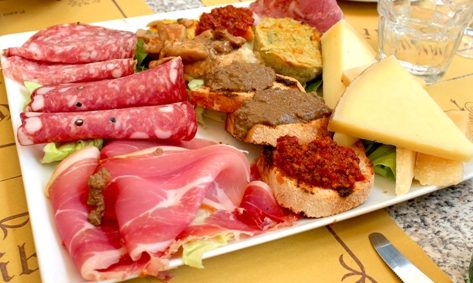
by Nicole Clausing
“Nobody eats in Florence anymore,” sniffs my father’s new friend, an Italian ex-pat now living in San Francisco. “There are no good restaurants in the city.”
Well, alrighty then.
That comment is a little bit of a buzz-kill for Dad, my Mom, my sister, and myself, as we are about to embark upon a week of eating our way through Tuscany’s largest city. But the closer we get to departure, the more the snooty statement begins to seem like a challenge to be met. Just try to keep four Clausings from the good eats, I think, as I’m packing and planning. By the time we arrive, it’s fully on: We are going to eat well, if we have to make the food ourselves.
At the end of the week, after a long, glorious process of trial and surprisingly little error, we have learned a few things about eating well in Florence. The gist of what we learned can be summed up in one simple rule: It’s almost impossible to go wrong if you eat like a Florentine.
When in Florence…
How do you eat like a local? Start by eating when they do. Florentines, like many Europeans, eat their big meal in the middle of the day. Don’t be afraid to budget plenty of time and Euros for a big lunch, complete with wine. Yes, you may have a little bit of a food coma going on after lunch. So does most of Italy. Many establishments close for a few hours in the middle of the day while the workers sleep it off, so you’re really not missing much while you’re at the table.
Secondly, eat what the locals do. Meaty specialties of the city include bistecca, or grilled T-bone steak; and Cinghiale, or wild boar. And if you’re ever going to like tripe, it will be here, where the locals pride themselves on the dish. Same goes for chicken liver, which is often eaten on crostini. On the less carnivorous side, a signature dish of the city is ribollita, a vegetable soup thickened with chunks of bread. (Florentine bread, by the way, is traditionally unsalted and many Americans find it to be an acquired taste—or lack thereof.) Favorite veggies include asparagus, spinach, artichoke, and white beans.
Lastly, don’t forget to eat how Florentines do. For the mid-day meal, it’s traditional to eat several courses at a sitting. Start with antipasti; maybe a plate of charcuterie shared with the table, or some of those chicken-liver crostini. Move to a primi, or first course, which is often pasta. It won’t be the devastatingly heavy slice of lasagna or pile of fettuccini Alfredo that you might be expecting. It will be a modestly sized portion of perhaps pappardelle with a boar or rabbit ragu, or Pasta e fagioli (spaghetti noodles with beans), a combo that might seem counterintuitive at first, but which is a Florentine favorite.
Then it’s on to secondi, or main courses. These are usually protein-based—here’s where you might try the famous bisteca, or tripe. If that seems a little heavy, be sure to peruse the contorni section of the menu. These are side dishes, and you’ll find plenty of greenery here. Finally, try to save room for dolci—dessert. (Don’t feel you have to do every course—we only succeeded once, and felt like we overdid it.)

Debunking the Theory
Most of this knowledge is in my future the day we arrive in Florence. We still have a lot of adventures ahead of us. We will, contrary to my father’s friend’s snarky advice, dine at many restaurants in the city. In a week of restaurant lunches, only one disappoints at all. That experience taught us an important rule: If you travel to Florence at the height of the tourist season, and still manage to find a deserted restaurant…keep walking. It’s probably empty for a reason. (Over-salted pork and charred chicken, in our case.)
Early on, we find ourselves in the neighborhood of the Sant’Ambrosio market and decide to take a chance on a restaurant, Trattoria Il Giova (73 Borgo la Croce; 39-055-248-0639; Ilgiova.com/menu.html), that my father’s research indicates has had an up-and-down history. We catch it on a glorious upswing, and it turns out to be one of our favorites. The interior is tiny but sun-drenched, and the white walls are decorated with charming cartoonish drawings of animals. Most have captions in Italian and my sister and I, non-Italian speakers, amuse ourselves trying to decipher them. (Our favorite: Two Gary Larson-esque cows nervously ask a maître ‘d “Do you have anything vegetarian?”)
Lunch is nothing like what I expected from Italy. I don’t have a bite of pasta all afternoon. No cheese or heavy meat, either. My main course is chilled farro studded with tiny shrimp, mussels, and bits of tender octopus. It’s subtle and refreshing, two words I’ve never associated with Italian cuisine, and it’s fantastic.
Another mid-day finds us rewarding ourselves for a brisk morning walk to the Santa Maria Novella church with a signature Florentine dining experience, bistecca at Trattoria Mario (2 Via Rosina; 39-055-21-8550; Trattoria-Mario.com/Site-2013/index.php). Mario is not exactly a secret, as secret places aren’t as packed with humanity as this, but it’s the kind of popular place that’s popular for a reason, and well worth a visit. This is my second time, and it’s a bit different from my first visit. The first time I ate here, several years ago, we dined in the impossibly packed upstairs area, where tables are spaced seemingly inches apart. The waiter asked us how many etti of meat we wished to order (an etto is 100 grams, or 3.5 ounces). A few minutes later, he brought out a huge chunk of raw T-bone for our approval. Nearby diners applauded, which seemed like a good sign. The steak was whisked back into the kitchen, and returned to us well salted and seared on the outside, rare and tender and flavorful on the inside. We finished it like Neanderthals and left a clean bone. When the waiter took it away, our companions applauded again. It was a proud moment for a family in touch with its Paleolithic roots.
This time, we are seated in a much smaller and quieter downstairs room. I miss the applause a little (it’s a rush; I’m not going to lie), but it’s nice to have elbow room. I’m seated next to a dusty wine rack holding bottles older than myself. As if to remind us that we’re in a foreign country, the room is decorated with soccer posters dripping with vitriol about rivalries I’m only dimly aware exist. (“Turin and Florence united against Juventus;” “Juve Merde.”) We order a piece of beef from Italy’s native Chianina cattle. It arrives perfectly charred on the outside, and quite red on the inside, just a few moments on the safe side of bloody for my taste. It’s accompanied by one sole side dish, the best white beans I’ve ever had. Creamy and salty, they have an umami heartiness that forever changes the way I feel about legumes—now they’re not just for soup anymore. (Later we find out that the beans have most likely been cooked with Parmesan rinds and bits of pork tendon to add richness.)
On Father’s Day, we go to a restaurant that is a long walk from our apartment. That’s good because we’re probably only alive because of the exercise. It is at I Ghibellini (8 Piazza di San Pier Maggiore; 39-055-21-4424; IGhibellini.com/ing_index.php) that we discover the pleasure and pain of a full multi-course Italian feast. We start with a shared charcuterie plate that frankly, might be enough to get us through to an early dinner. But we are just getting started. Rustic, torn sheets of pasta topped with meat sauce follow for me, and then I make a stab at some roasted chicken. And it’s not just that. Celebratory proseco turns to Chianti and is capped by a surprise complimentary shot of limoncello each. It was great, but all of us toddled back home and immediately collapsed for the rest of the afternoon. Next time I might just have some of the pizza they are known for.

If You Want Something Done Right…
During the course of our vacation, we will also experiment with making our own Italian family dinners. We rent an apartment with a full kitchen where we eat every morning and most evenings. Forays out for provisions are some of the most interesting experiences of our trip. Our Oltrarno neighborhood, where artisans still toil in centuries-old workshops making the leather and paper goods the city has been famous for since the Middle Ages, feels a little like a time capsule. So it’s surprising to find a supermarket, Sapori & Dintorni Conad (45 Via de Bardi; 39-055-29-0388; Conad.it/Conad/home/puntivendita/dettaglio.html?idPdv=5480), modern and gleaming, close to our home base. It’s very much like an American grocery store, with a few surprising finds. Some are pleasant, like the discovery of a cheese case taking up what seems like a quarter of the store. Some are a little unsettling, like the rabbit heads on Styrofoam trays lurking among the pork chops and chicken breasts in the meat section.
We go here several times, but our most interesting grocery run by far is to the city’s Sant’Ambrosio market (Piazza Lorenzo Ghiberti). This year-round market, with indoor and outdoor components, is the perfect place to go if you want to eat like an Italian because it forces you to shop like an Italian, buying fresh seasonal produce and local organic meats. Outside, we find row upon row of fruits and vegetables, which in June include cherries that look ready to burst with juice, gorgeous edible squash blossoms, and tomatoes that put American supermarket versions to shame.
Inside, we find that everything is familiar and strange at the same time. A poultry case is full of oddly golden chickens—they must be eating something saffron-like at this time of year. Dwarfing them is the largest dead bird I have ever seen. It’s too big to be a turkey, even, and we speculate that it’s an ostrich, though no one’s Italian is up to investigating further.
There are plenty of conventional-looking foodstuffs around, including prosciutto for days and rows and rows of cheeses. But we’re feeling adventurous so we go home with two stuffed chicken necks with the heads still on. Inside is pistachio nut-studded sausage. We don’t know how it is done, or why—it strikes me as more like an early draft of turducken than something that should actually be eaten, but it’s unnervingly good. We eat it along with tomato and fresh mozzarella from the market and thick pici pasta and tomato sauce from—gasp!—a bottle. (Yes, Italians take this shortcut, too.) It’s another banner eating day.

A Word on Gelato
My sister, Hilary, and I, are both adult women with jobs and apartments and independent lives. We are also both powerless in the face of dairy fat. Grown as we are, every time our parents take a nap or go out for a stroll, we sneak out like delinquent teenagers and score some gelato.
After a week exhaustively researching the city’s gelaterias, we can say with a scientific degree of certainty that it’s almost all good. And some is great. One trick we learn is to look at the containers that the gelato is stored in. Those open metal tubs piled high with wave upon wave of ice cream are fun to look at, but establishments like this tend not to have the freshest, or frankly, the most sanitary gelato. Look for gelato that comes out of metal cans with lids. This tends to be the best, freshest stuff.
We find the canisters at Grom (24 Via delle Oche; 39-055-21-6158; Grom.it/en/gelaterie.php), which is a chain, but one with an obsessive devotion to natural ingredients like cage-free eggs. To our delight, gelato is also served this way at a place within dashing distance of our apartment near the Pitti Palace, Gelateria della Passara (15 Via Toscanella; 39-055-29-1882; GelateriaLaPassera.wordpress.com). They’re also found at our very favorite of all, La Strega Nocciola—the Nutty Witch (51 Via De’Bardi; 39-055-238-2150; LaStregaNocciola.it). Italian gelato shops usually stick to fairly traditional flavors (except maybe with more almond than you’re used to), but La Strega gets a little baroque. We love their crema (it’s like sweet cream, but eggier, with a hint of lemon) but we really flip for vanilla studded with marble-sized, Nutella-filled profiteroles. We go nutty for it indeed and slip out for it so often that we worry our parents can smell hazelnut on our breath.

Heading for the Hills
Towards the end of the week, we remember my father’s friend’s pronouncement that the best food in Tuscany is found outside of Florence. We’ve eaten well. Could it possibly get better? There’s only one way to find out, so we walk across town to the Piazza di San Mario, get on the #7 bus, and ride it about 40 minutes to the end of the line, which is at Fiesole, a small town in the hills outside of Florence.
Fiesole has a beautiful Romanesque church and a preserved monastery dating from 1399 which are both worth a visit. But the best parts of Fiesole on the beautiful day we visit are the spectacular views of Florence and the Arno Valley, and lunch at Ristorante La Reggia degli Etruschi (18 Via San Francesco, Fiesole; 39-055-59385; LaReggiaDegliEtruschi.com).
La Reggia is reached by a strenuous walk up a steep hill from the center of town. It’s work, and we’re not even trying it in heels like all the impossibly well-dressed Italian women we see everywhere. The walk is more than worth the huffing and puffing though, as the dishes we encounter there are arguably some of the best and most sophisticated things we’ve had that didn’t come out of a lidded metal container.
Primi that we taste include a creamy, earthy porcini mushroom risotto that is much heartier than you might expect, and an eggplant/ricotta ravioli that is surprisingly light in texture. Rare beef tagliata is barely warm in the center, but meltingly tender. A side of zucchini flan sounds offbeat but is a revelation. It’s smooth and savory and eggy, and I realize that after this, creamed or buttered veggies just won’t cut it anymore. Vegetables now demand a full custard treatment.
After nearly a week in Florence with its summer crowds and narrow streets, it’s glorious to be literally above it all. The loudest noise we hear is a blackbird serenading us in a nearby tree. The air is cool and we feel like we can see to Spain from here. We linger as long as we feel we can, nursing tiny cups of espresso in the sun.
Afterward, we make our way back down the hill and try not to fall asleep on the bus. It’s a mercifully flat walk back to our apartment, but it takes a while and we’ve got plenty of time to digest, so to speak, all that we’ve taken in over the past week. I remember our food-critic friend’s pronouncement and decide that quibbling over where the best eats are is silly in a place where you can almost literally turn over a rock and find something delicious. (Truffles! Yum!)
No good food in Florence? Here’s how I look at it: There’s plenty of good food in me, and I’m in Florence, so it’s a first-class dining destination as far as I’m concerned.
To book your Tuscany vacation, contact Heather Cassell at Girls That Roam Travel at Travel Advisors of Los Gatos at 408-354-6531at or .
To contract an original article, purchase reprints or become a media partner, contact .







